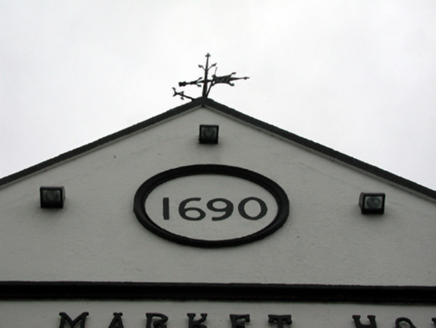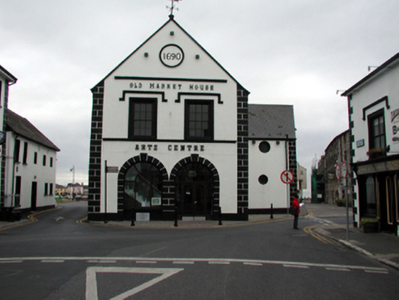Survey Data
Reg No
22821147
Rating
Regional
Categories of Special Interest
Archaeological, Architectural, Historical, Social
Original Use
Market house
In Use As
Building misc
Date
1685 - 1695
Coordinates
226295, 93008
Date Recorded
02/09/2003
Date Updated
--/--/--
Description
Detached two-bay two-storey gable-fronted market house, dated 1690, on an L-shaped plan with pair of round-headed carriageways to ground floor, and two-bay two-storey return to east having two-bay single-storey double-pile wing with half-attic to south. Extensively renovated, 2000, to accommodate use as arts centre. Pitched roofs (gable-fronted to main block; double-pile (M-profile) to wing) with replacement artificial slate, 2000, replacement square rooflights, 2000, and replacement uPVC rainwater goods, 2000. Painted replacement cement rendered walls, 2000, with rendered quoined piers to corners, moulded rendered courses first floor and to gable (surmounting raised lettering to gable) with moulded rendered date stone to gable. Square-headed window openings with rendered sills (forming sill course to first floor), moulded rendered surrounds, and replacement 6/6 timber sash windows, 2000. Oculus window openings to wing with concave reveals, and replacement fixed-pane timber windows, 2000. Pair of round-headed carriageways to ground floor probably originally forming open arcade with rendered surrounds having keystones, and replacement glazed timber doors, 2000, having sidelights, and overlights. Road fronted at junction of three roads with concrete brick cobbled footpath to front.
Appraisal
An appealing, modest-scale building forming an attractive landmark terminating the vista from Main Street (Parnell Street) to the west. Distinctive characteristics, including the steeply-pitched roof, identify the medieval quality of the composition, and attest to the importance of the site in the archaeological heritage of Dungarvan. Further attributes, including the openings to ground floor, identify a standard market house plan comprising an open arcade having a governor’s room over. Reasonably well converted to an alternative use, retaining much of the original form and massing, the market house remains an integral component of the architectural heritage of the locality. The market house is of additional importance for its historic associations with Edmond Power (d. 1799).



